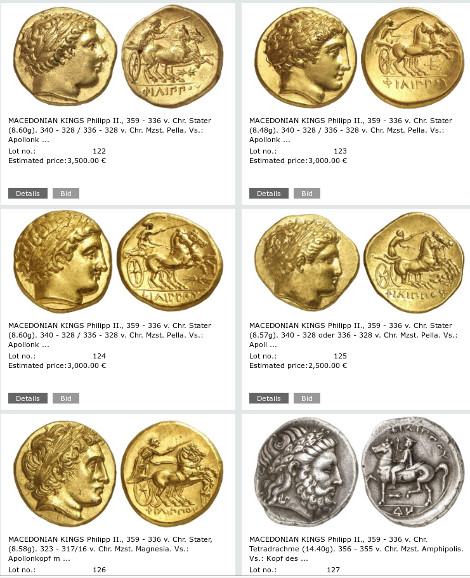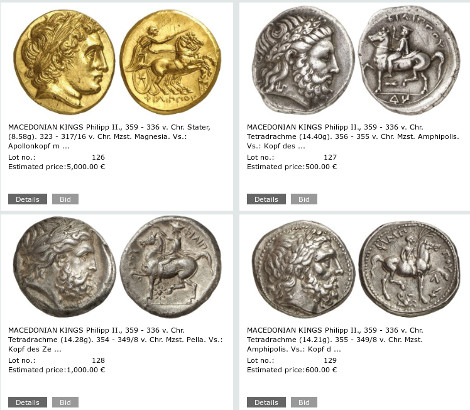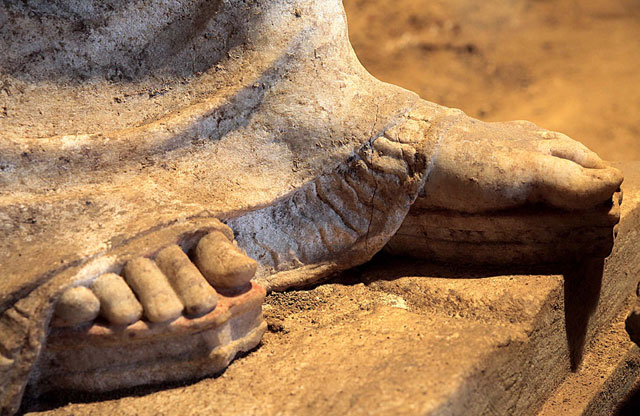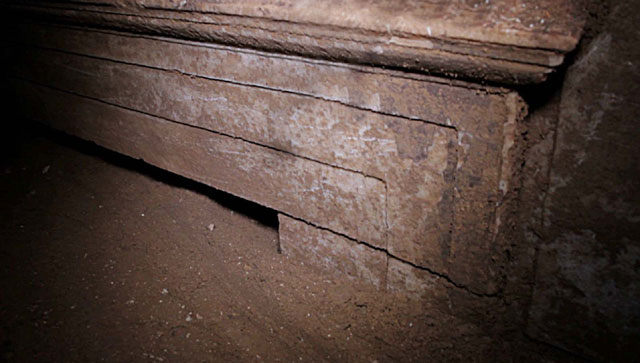In one of the most critical moments of the excavations in the tomb in Amphipolis, an auction will take place in Germany that will offer for sale ancient coins from the same region and from the time of Philip of Macedon and Alexander the Great.

According to the Greek media, it is unclear how they have ended up in Germany. The auction will take place in Munich in October and the coin prices start from 500 euro and go as high as 2,500 euro. In addition, the price of a few coins exceeds that amount.

At the same time, an increasing number of archaeologists claim that the tomb in Amphipolis was robbed by treasure hunters. "Large amounts of soil have been taken out from the tomb so far and I am very well aware of the fact that they have been screened. Haven’t they found anything? Why don’t they tell us? Haven’t they found nails? Nails are true artefacts. When you find nails, very large in size, you immediately say, ‘we have a wooden stretcher,’" said honorary director of Ancient Artefacts Department Catherine Romiopoulou before Eleftheros Typos newspaper. She said that before setting fire to the pyre they would put the dead man on a wooden bed or stretcher with a feather mattress covered with expensive woven fabrics. The deceased person was also dressed in gold-embroidered garments.
"The ceremony of setting fire to the pyre was carried out on the grave or near it, on its roof, as was the case in Vergina or behind it as in Lefkada, or slightly away from it. The stretcher with the deceased and all valuable things that they thought would accompany him or her in the afterlife through the fire, including jewellery, dishes and other items were placed on the pyre too. The remains in the fire, the ashes and bones of the dead as well as the half-burnt golden crown were wrapped in an expensive cloth and put in an urn that was made of gold, silver or bronze. Today we find them covered with rust and green with patina, but they were shining like gold after they were made. Then they put the urn in the grave, not directly in the soil but in a stone container. Sometimes they put a bench in the graves and various utensils on it. The utensils that were placed on the edge of the pyre remained in a better state. Furthermore, in the case of important people, their burial chambers were not empty but lined with ivory and bronze ornaments."
For these reasons Romiopoulou believes that the tomb in Amphipolis was looted by treasure hunters, as well as the Macedonian grave found on the Kasta hill, which she herself excavated in the 1960s.
"How do thieves enter the grave? They enter it from the top. They opened one, two, three holes and, of course, the soil had consequently fallen inside. I do not accept the theory that the soil was used to reinforce the structure. The mound of soil is cone-shaped and it is in the middle of the grave, not supporting the walls. Treasure hunting had to be interrupted and this could only be achieved through systematic excavations. The region around the valley of the Struma River has always been a field of activity for treasure hunters," she says.
Commenting on the uniqueness of the tomb in Amphipolis, Romiopoulou states, "These ideas (regarding the decoration - author’s note) are not only the result of the authors of the tomb. They are the result of their customers’ imagination too. If the customer was an aristocrat and had money, he or she could want everything. A good master was able to fulfil this desire."
In her opinion, the tomb was built in the last quarter of the 4th century BC, between the years 325 and 300 BC. Catherine Romiopoulou is surprised by the idea of the authors to put the two fine statues of the caryatids inside it. "Roman art brings coldness. It is beautiful as craftsmanship but it is lifeless. The caryatids are copies, but they have their body and soul. I think they were cut in the middle of the 3rd century, about 250 BC."

"The caryatids in Amphipolis show us their legs, the make of which is exceptionally detailed. We see the same in the caryatids in the Erechtheum on the Acropolis. Look at the female figures in the sanctuary at Delphi. They are the original prototype. The statues did not appear in the 5th century BC for the first time but in the early 6th century BC," said the archaeologist.
She is impressed by the distribution of the rooms in the tomb in Amphipolis and describes them as a "coach" or "tunnel" divided into various rooms and defines as unique the entrances that have been discovered up to this day. "Usually we find marble doors in graves, which close the anteroom," she told the newspaper.
No doors have been found in Amphipolis even to this day. The entrances are wide open which causes a lot of debate among archaeologists. Some even believe that actually the tomb could have been a mausoleum opened to visitors at that time.

Catherine Romiopoulou in turn tries to guess the idea that inspired the authors of the tomb. "They probably left open the entrances in order to put the monuments on both sides. Their idea was to pass from one door to the next. This was the work of skilled masters. The graves were not the work of one person. The builders were united in groups and the chief master was the leading figure, followed by the second master and the slaves. This is how this tomb was built." She notes that if it is established that it was used in different eras, the items that will be found will have different chronology.